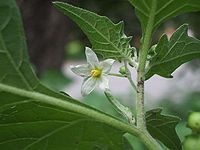
Photo from wikipedia
Black nightshade (Solanum nigrum) is a kind of common malignant weed in the agricultural fields worldwide. In recent years, it has not been well controlled under the commercial rate of… Click to show full abstract
Black nightshade (Solanum nigrum) is a kind of common malignant weed in the agricultural fields worldwide. In recent years, it has not been well controlled under the commercial rate of glyphosate application in some areas of Hunan Province in China. To evaluate and confirm the glyphosate resistant biotypes of S. nigrum, the seeds of ten suspected glyphosate resistant populations of S. nigrum were collected in the agricultural fields from this province. Their GR50 values and glyphosate resistance were determined by the biomass method, the comprehensive index of pesticide injury method, and the leaf discs method independently. The results showed that ‘r1, r2, r3, and r9’ populations were of moderate resistance levels to glyphosate. But the shikimic acid levels in S. nigrum did not display a typical sigmoidal curve to glyphosate resistance, supporting that the mechanism of different resistance might be involved among the glyphosate resistant biotypes in S. nigrum.
Journal Title: ScienceAsia
Year Published: 2019
Link to full text (if available)
Share on Social Media: Sign Up to like & get
recommendations!